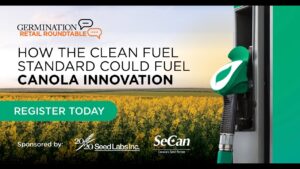At the ASTA CSS & Seed Expo, experts highlight regulatory changes and business changes that are moving towards a more sustainable future.
When you think about climate-smart policies, your mind might automatically jump to the European Union’s Farm-to-Fork section of their Green Deal. There are key elements there for agriculture — reduce pesticide use on crops, fruits and vegetables by 50%, cut nutrient losses on farmed ground by 50%, requiring farmers use 20% less fertilizer and boost overall organic production to 25% of the total.
But, the EU isn’t the only sector in the globe looking to a more sustainable future through regulation and business changes.
The U.S., although not looking at country-wide adoption of climate-smart policies, has a few states looking hard to reduce carbon emissions by 2050, including New York, Virginia, Colorado, North Carolina and more states. One path they see forward in working towards those goals? Through renewable fuel and low carbon fuel standards.
The drive? A more sustainable future, not only in agriculture, but throughout the entire economy and supply chain.
What’s the sector look like in terms of business changes? How is it going to affect the seed sector? That’s one question the American Seed Trade Association’s (ASTA) CSS & Seed Expo wanted to ask before the onset of 2023.
Incentives Driven by State Initiatives
In the policy sector in the U.S., there’s a lot going on in the realm of energy and the move towards climate smart policies.
Things such as renewable fuel or renewable diesel are already playing a huge role in that, says Tristan Brown, director of the Bioeconomy Development Institute at the SUNY College of Environmental Science and Forestry.
Especially in the road freight sector, when you think about the long haul of heavy-duty applications like construction and agriculture equipment, Brown says this is going to require liquid fuels for the foreseeable future. Particularly due to new decarbonization targets — like targets laid out by low carbon fuel standards, which are being implemented by different states across the U.S.
“If we’re really going to be net zero, we have to start displacing fossil fuel consumption, which means petrochemicals,” he says.
The idea behind low carbon fuel standards is to incentivize the reductions in carbon intensity of fuels that are currently used in the transportation sector — or, the larger your reduction in carbon intensity, the greater incentive you get.
“This is really different than what we’ve seen at the federal level with a number of the old blending tax credits or the Renewable Fuel Standard,” Brown says. “This is really driven decarbonization of the transportation sector and the states that have adopted it — and we have a number of states that are also considering it in the Midwest. This would be a great drive in the demand for renewable diesel.”
But, as the renewable fuel is being driven by low carbon fuel standards, carbon intensity of feedstock matters.
“This can mean using low to no-till systems,” Brown says. “It’s convenient adopting more sustainable practices at the farmer level because it will actually increase the incentive that renewable diesel will receive.”
Energy and Agriculture
When it comes to energy, Kerry Trombley, senior business development advisor for Marathon Petroleum, sees its future tied together with agriculture. Historically, that’s been the case, and as the move towards sustainability continues — especially with the idea of renewable fuel coming to light — both will share a future.
As the U.S. shifts focus to low carbon intensity and low carbon fuels, he believes the energy sector and the seed sector will need to work together to meet their goals.
How? Through renewable fuels and biodiesel.
“We see ag and energy becoming more intertwined, but that really got kick-started in 2005 with the passing of the Renewable Fuel Standard (RFS),” Trombley says, adding that the standard kicked off a focus to help the U.S. create their own energy domestically by focusing more on volume than carbon intensity.
Though that kicked the energy evolution off in 2005, there’s a second energy evolution occurring right now being driven by policies containing low carbon fuel standards, with California leading the pack.
“It shifts the focus from just the volume requirement of renewable fuels to be a carbon intensity requirement for renewable fuels,” Trombley says. “A gallon of biodiesel, which under the RFS was the same whether it was created from soybean oil of from a used cooking oil? Now those are incentivized differently.”
And while these standards are different and are causing changes throughout the U.S., Trombley says that there’s never been such an integration into the existing transportation market — though it’s not without its challenges.
Consumer acceptance of lower carbon fuels and scalability will be a challenge, he adds.
“Renewable diesel is not biodiesel — biodiesel has blending issues, he says. “Renewable diesel is a 100% drop in fuel. You put it in the engine and it will not know the difference — but scale is going to be a big problem.”
Under the current feedstock constraints, Trombley says you can’t accomplish the goal of decarbonization sustainability given the challenges of scaling, but he believes proper policy can drive industries to innovation and solutions.
“Regenerative and sustainable agricultural practices have demonstrated positive carbon impact should be recognized and incentivized as part of state and national programs,” he says. “Innovative approaches, such as reduced fertilizer usage, cover crops and any way to reduce the land usage should be encouraged as part of the policies.
“Energy has a diverse future,” Trombley says. “The continued growth between ag and energy where our sustainability practices overlap and where they’re incentivized will continue to grow the renewable liquid fuels business.”













